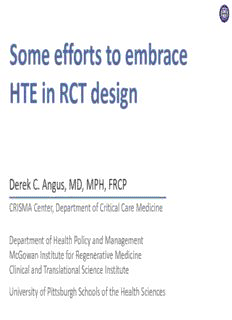
Derek C. Angus PDF
Preview Derek C. Angus
Some efforts to embrace HTE in RCT design Derek C. Angus, MD, MPH, FRCP CRISMA Center, Department of Critical Care Medicine Department of Health Policy and Management McGowan Institute for Regenerative Medicine Clinical and Translational Science Institute University of Pittsburgh Schools of the Health Sciences • The 4 dimensions of heterogeneity of treatment effect • Baseline probability of incurring disease-related event • Responsiveness to the treatment • Vulnerability to adverse events • Utilities for different outcomes • In truth, there are several more! Kravitz et al. Milbank Q 2004 • The 4 dimensions of heterogeneity of treatment effect • Baseline probability of incurring disease-related event • Responsiveness to the treatment • Vulnerability to adverse events • Utilities for different outcomes Kravitz et al. Milbank Q 2004 • The 4 dimensions of heterogeneity of treatment effect • Baseline probability of incurring disease-related event • Responsiveness to the treatment • Vulnerability to adverse events • Utilities for different outcomes Kravitz et al. Milbank Q 2004 Risk of disease & risk of adverse events Heterogeneity of Treatment Effect (HTE) • A re-analysis of the European Carotid Surgery Trial (ECST) • There is huge heterogeneity even within the same trial … Rothwell PM. Lancet 1995 What are typical distributions? TYPICAL RCT POPULATION DISTRIBUTION Kent & Hayward. JAMA 2007 Knaus et al. CHEST 1991 • The typical risk distribution in all clinical trials is left-shifted • Median risk is always lower than average risk t e N • Assuming • Left-biased distribution • Flat hazard and constant RRR • Positive trial driven by large effect in minority of high-risk patients • Implications • Changing net RRR across outcome risk • Median patient derives no benefit, and half are harmed • Typical subgroup analysis tests differences to the right of the median case Kent & Hayward. JAMA 2007 Drotrecogin alfa for sepsis … • Multivariable subgroup analysis • Despite frequency of such analyses for RCTs in NEJM, JAMA, or Lancet <1% • Left-bias • 1,070 (63%) patients to the left of the average baseline risk • Benefit in a minority of high-risk patients Ely et al. Crit Care Med 2003 Responsiveness to treatment
Description: